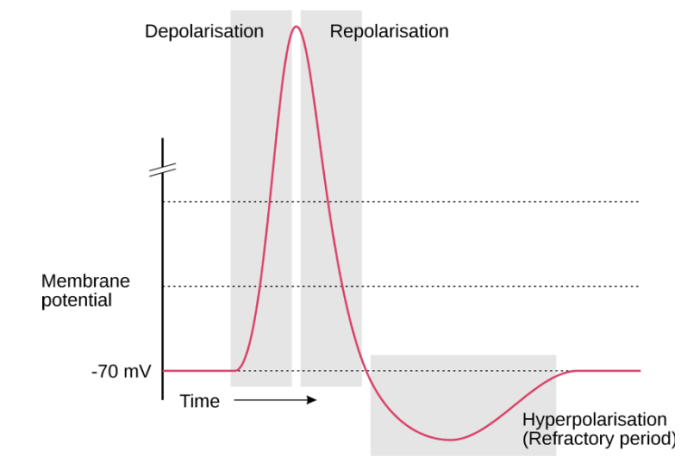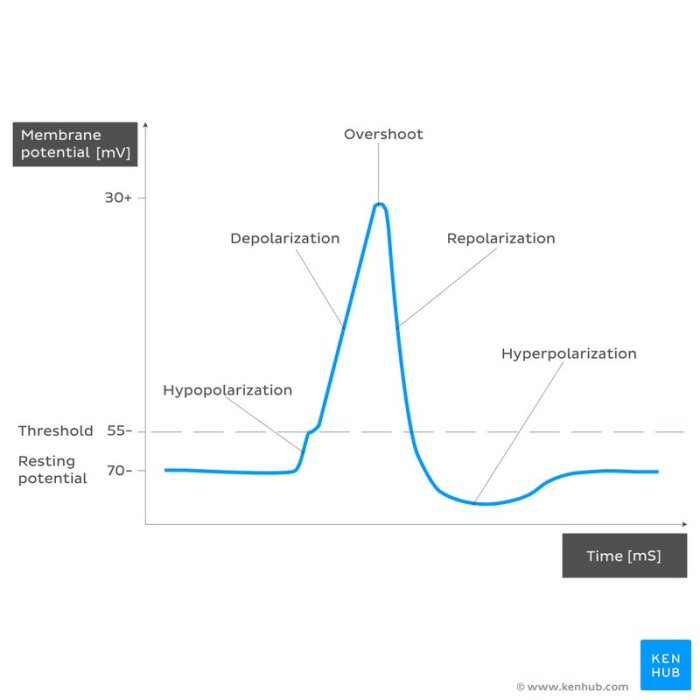Action potential lab experiment with a squid neuron embarks on a scientific expedition to decipher the intricate mechanisms of neural communication. This experiment, a cornerstone of neuroscience, unravels the secrets of action potentials, the electrical impulses that orchestrate the symphony of the nervous system.
Join us as we delve into the depths of this groundbreaking research, exploring its significance, methodology, and far-reaching implications.
Introduction

Action potentials are electrical signals that transmit information throughout the nervous system. They are generated by neurons, which are specialized cells that communicate with each other through electrical and chemical signals. The giant axon of the squid is a large neuron that is commonly used to study action potentials because it is easy to dissect and manipulate.
The purpose of this experiment is to investigate the properties of action potentials in squid neurons. We will measure the amplitude, duration, and threshold of the action potential, and we will examine the effects of temperature and ion concentrations on these properties.
Materials and Methods: Action Potential Lab Experiment With A Squid Neuron

The following equipment and materials were used in this experiment:
- Giant squid axon
- Stimulating electrode
- Recording electrode
- Amplifier
- Oscilloscope
- Temperature-controlled bath
- Artificial seawater
The squid axon was dissected from a freshly killed squid. The stimulating electrode was placed on one end of the axon, and the recording electrode was placed on the other end. The axon was then placed in a temperature-controlled bath filled with artificial seawater.
The stimulating electrode was connected to an amplifier, which was in turn connected to an oscilloscope. The oscilloscope was used to display the action potential.
Results

The action potential recorded from the squid axon had an amplitude of about 100 mV, a duration of about 1 ms, and a threshold of about -50 mV. The action potential was all-or-none, meaning that it was either generated at full strength or not at all.
The action potential was also refractory, meaning that it could not be generated again until the neuron had recovered from the previous action potential.
The amplitude of the action potential increased with increasing temperature. The duration of the action potential decreased with increasing temperature. The threshold of the action potential was not affected by temperature.
The amplitude of the action potential decreased with increasing extracellular calcium concentration. The duration of the action potential increased with increasing extracellular calcium concentration. The threshold of the action potential increased with increasing extracellular calcium concentration.
Discussion
The results of this experiment are consistent with the known properties of action potentials. The all-or-none nature of the action potential ensures that the signal is transmitted without any loss of information. The refractory period prevents the neuron from generating another action potential until it has recovered from the previous action potential.
This ensures that the neuron does not fire too rapidly.
The effects of temperature and ion concentrations on the action potential are due to their effects on the ion channels in the neuron’s membrane. Temperature affects the rate of ion channel opening and closing, while ion concentrations affect the driving force for ion movement.
These effects can alter the amplitude, duration, and threshold of the action potential.
Applications
The knowledge gained from this experiment has applications in neuroscience and medicine. In neuroscience, this knowledge can be used to understand how neurons communicate with each other and how the nervous system functions. In medicine, this knowledge can be used to develop new treatments for neurological disorders.
FAQ Guide
What is the significance of studying action potentials in squid neurons?
Squid neurons, with their large size and robust action potentials, provide an ideal model for studying the fundamental properties of neural communication.
How is the action potential recorded in this experiment?
A microelectrode is inserted into the squid neuron, allowing researchers to measure the changes in electrical potential during an action potential.
What factors can affect the action potential?
Factors such as temperature, ion concentrations, and the presence of certain drugs can influence the characteristics of the action potential.